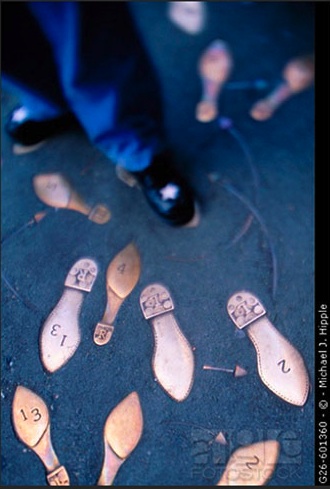 To photographer Mike Hipple, the claim is baseless. The photo he took about 10 years ago of a woman standing near the "Dance Steps on Broadway" sculpture in Seattle's Capitol Hill is an example of fair use. If it's not, he reasons, the right of all photographers to take pictures in public will be in jeopardy.
To photographer Mike Hipple, the claim is baseless. The photo he took about 10 years ago of a woman standing near the "Dance Steps on Broadway" sculpture in Seattle's Capitol Hill is an example of fair use. If it's not, he reasons, the right of all photographers to take pictures in public will be in jeopardy.
His photo was, after all, "taken on a public sidewalk, showing a woman interacting with a piece of public art, paid for by public funds. And it only depicts a small portion of the artwork at that," Hipple wrote. "Now if this doesn't qualify as fair use of the sculpture, I don't know what does."
Hipple's sentiment is shared by many Seattle residents who feel that public art, financed with their tax dollars, should be in the public domain. They paid for it, say residents, so they should be able to photograph it without fear of a lawsuit. Hipple is just a small-guy photographer being bullied by a greedy litigious copyright holder, they say. It's an understandable sentiment, but not necessarily a solid legal defense.
Hipple sold the photo (pictured above) to a stock photography company. Jack Mackie, who created "Dance Steps on Broadway," demanded that the company remove the photo, claiming that it infringed his copyright by reproducing the sculpture. The company promptly removed the photo, but Mackie sued Hipple last February for selling it in the first place.
The lawsuit has outraged scores of residents who find Mackie to be out of step with the public's interest. Mackie installed the eight sets of inlaid bronze shoe prints, mapping out well-known dances such as the waltz and rumba, in 1982 when the city rebuilt the neighborhood's sidewalks. Despite receiving public financing for the project, Mackie retained rights to the artwork. Those rights, according to § 106 of the U.S. Copyright Act, include the exclusive right to reproduce the work or to create derivative work from it.
Hipple does have a decent, if not bulletproof, fair use argument. Courts consider four well-known factors when determining if fair use applies: (1) The purpose and character of the use, including whether the use is of a commercial nature or is for nonprofit educational purposes; (2) The nature of the copyrighted work; (3) The amount and substantiality of the portion used in relation to the copyrighted work as a whole; and (4) The effect of the use upon the potential market for or value of the copyrighted work.
On factor 1, Hipple's use could be deemed moderately transformative. The photograph arguably adds a new meaning or message to the original, rather than simply duplicating or substituting for it. The aesthetic focus is on public interaction with the urban street—something not within the purview of the original. That said, Hipple's commercial use of the photograph hurts his case. But commercial use is not determinative. See Campbell v. Acuff-Rose Music, 510 U.S. 569 (1994) (finding that commercial rap parody constituted fair use). Although courts consider the commercial nature of the use as part of the analysis, they will not brand a transformative use unfair simply because it makes a profit.
On factor 2, Mackie's got the best of the argument because his work is creative and fanciful, rather than factual (despite some rather creative arguments made in Hipple's motion to dismiss the lawsuit). Factor 3 is hard to judge without seeing Mackie's statute first-hand. Hipple may have a good argument that he has used only a small portion of "Dance Steps on Broadway" in his photo. On factor 4, it's hard to imagine how the photo hurts the "market" for Mackie's public artwork, unless he can show that there is a non-speculative licensing market.
All in all, though, it's a hard call. Others in Hipple's position have caved in to similar demands. People and Sunset magazines, for example, settled with the artists behind Seattle's Fremont Troll after using photos of the landmark for non-editorial purposes. Mackie himself has pursued infringement claims for unauthorized use of his artwork at least 30 times.
Cities like Seattle should reconsider how they commission public artwork. Cities could demand that artists surrender their copyright interests in order to receive public funding. Another resolution, suggested by Susan Richey of Franklin Park Law Center, would have been to institute a compulsory licensing scheme for photographing public art.
But any scheme that involves paying to photograph seems antithetical to the public interest. The most reasonable solution is to keep public artwork completely open to the public. Until cities do this, however, commercial photographers may want to think twice about incorporating public artwork into their photographs.
(Justin Silverman is a CMLP Legal Intern and a third-year evening student at Suffolk University Law School. Justin founded the law school's Suffolk Media Law student group and its SuffolkMediaLaw.com blog in 2009.)
Photo by Mike Hipple. Screenshot from Petapixel.




